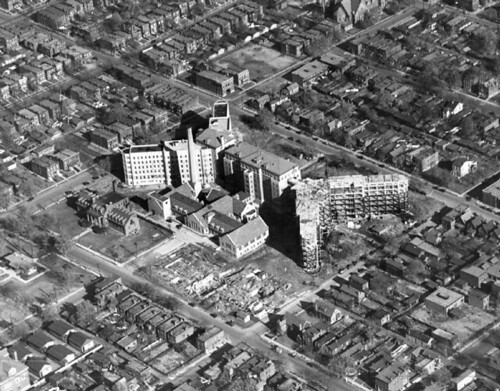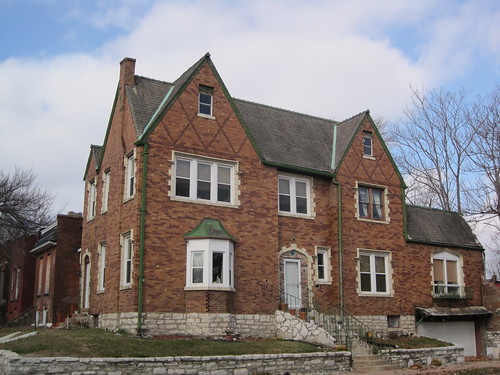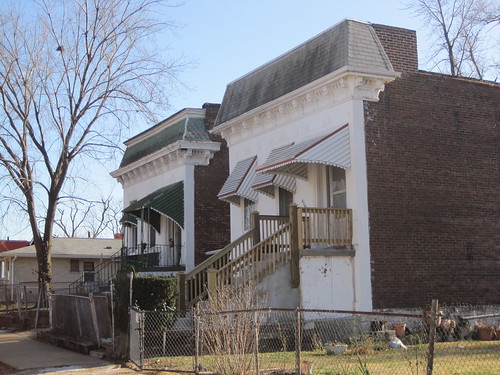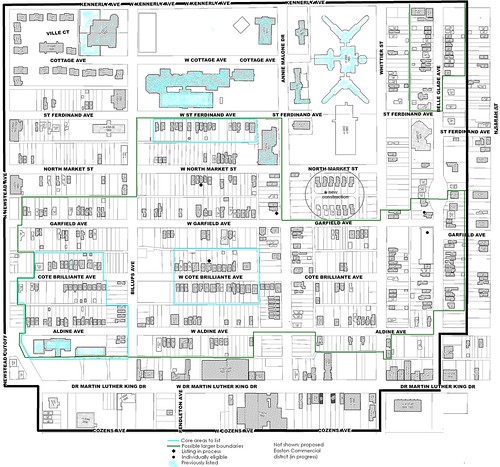by Lynn Josse and Michael R. Allen
Creating National Register of Historic Places historic district designations often is straightforward work — a consultant delineates the boundary of an eligible area dense with urban building stock. Then there are depleted neighborhoods in north St. Louis, where the levels of demolition make defensible boundaries more difficult. With extensive demolition marring its streetscapes, The Ville is no exception. Yet The Ville has a historic importance as the cultural center of African-American life in St. Louis rivaled only by the lost Mill Creek Valley.
Since 1987, The Ville has been a Local Historic District with restrictions on demolition, but until recently little of it had National Register of Historic Places status. Beyond the great cultural honor, that status makes available federal and state rehabilitation tax credits — the programs that revived Dick Gregory Place in the western end of the neighborhood. Since taking office in 2007, Alderman Sam Moore (D-4th) has pushed to find solutions for historic preservation of The Ville’s buildings, many of which face the wrecking ball in the absence of incentives for their reuse. One of the city’s most important neighborhoods seemed to be disappearing over the last few decades, but finally there may be a change in direction.

Between August 2009 and August 2010, under contract to city government, the Preservation Research Office (PRO) completed the first intensive architectural survey of the heart of St. Louis’ fragile yet historically significant African-American neighborhood The Ville. The “Heart of the Ville” survey was the result of the successful St. Louis Cultural Resources Office (CRO) application for a Historic Preservation Grant to survey the Ville neighborhood, a local historic district with outstanding significance and uneven integrity. PRO evaluated 368 primary resources and 49 secondary resources, all buildings, to form the basis for historic district nominations. As of this writing, three small Ville historic districts are now listed in the National Register of Historic Places based on the survey results. (See subsequent post.)


The survey was designed as a cooperative effort between the City of St. Louis CRO and Lynn Josse and Michael Allen at PRO. In November, 2009, PRO signed a contract with the city to provide a reconnaissance survey of 300 properties within the boundaries of the Ville neighborhood. Because this number would include fewer than half of the potentially historic residential and commercial properties within the originally identified survey area, CRO and the contractors targeted a much smaller set of blocks within the Ville. The new boundaries were selected based on the level of threat to the targeted resources.

This survey differed from many others because the neighborhood has already been the subject of intensive study over three decades. In 1983-84, Landmarks Association of St. Louis conducted a reconnaissance survey of the Ville. In 1987, the City of St. Louis designated most of the Ville neighborhood as a local historic district. Two years later, the National Park Service (NPS) rejected certification of the Ville Local Historic District — a process that allowed other neighborhoods to have both local and national designation — due to extensive building loss in parts of the district. Consequently, the Historic and Architectural Resources of the Ville Multiple Property Submission was developed by Landmarks Association of St. Louis and approved by the National Park Service in 1999. The MPS offers three contexts under which individual buildings or groups could be listed in the National Register. The contexts are: “Black Settlement in the Ville, 1865-1910” and “The Ville as a Center for African-American Culture, 1910-1950”. The MPS establishes registration requirements for Institutional Buildings but no other types, stating that this is “the first phase of what is hoped to be a long-term project of evaluating and registering properties in the Ville.”

The established registration requirements do not allow for listing of housing and commercial buildings. Thus, in 2009, the Cultural Resources Office submitted a third context: “The Ville Neighborhood as a Result of Local and National Racial Segregation Policies, 1915 – 1950.” This context outlined the demographic changes embodied by the remaining architectural resources of the Ville from that period. The context had never been approved by NPS.

In the survey area, three buildings had been listed in the National Register under the Historic and Architectural Resources of the Ville MPS. Antioch Baptist Church at 4713 North Market Street (NR 9/17/99) and Marshall School at 4342 Aldine Avenue (9/17/99) are both listed under the Institutional Buildings registration requirements. The Herman Dreer House at 4335 Cote Brilliant Avenue (2/20/09) was included in the National Register under a Supplemental Listing Record (SLR), meaning that the nomination provided enough context to include the building even though its property type was not documented in the MPDF.
On August 10, 2010, PRO submitted the survey report to CRO. This report was the basis for a second HPF grant to fund the submission of a modified MPS, prepared by CRO staff, and three historic district nominations, prepared by PRO. This work commenced by year’s end and led to approval of all four documents by the National Park Service on January 17, 2012.

Survey Results: Dealing With Depletion
As the map shows, the final determination was to proceed with listing three small historic districts under a revised Historic and Architectural Resources of the Ville Multiple Property Submission, completed by CRO while PRO was working on the survey and district nominations. Unfortunately, National Register criteria for integrity precluded more sweeping recommendations, although several individual buildings remain eligible in the survey area.


In order to be eligible as a historic district, a group of buildings must strongly convey historic character evinced during the Ville’s significant period of African-American settlement, 1910-1950. Unfortunately, many unique buildings included in the survey are in groups that are not eligible due to extensive demolition or a preponderance of “non-contributing” buildings. Buildings with heavy alterations that have lost historic architectural character become non-contributing. Ultimately, the “Heart of The Ville” proved as fragile as the consultants and CRO had assumed. We regret that more buildings cannot be listed in the National Register there.


Despite the completion of three nominations with the survey area, the survey report recommends several eligible single-site buildings significant to the neighborhood’s African-American heritage. These include churches and institutional buildings not yet listed under the MPS as well as a few residences of individuals whose lives are established as significant. Additionally, the survey only covered a small part of the larger Ville and Greater Ville neighborhoods. Much cultural resources work remains in the area that could safeguard some of the city’s most important African-American historic resources.

3 replies on “The Heart of The Ville Survey”
[…] Skip to content HomeAboutEcology of AbsenceWho We AreAppearancesArchitectural ToursConsulting ServicesPlacesIndex of BuildingsIndex of PlacesNorth St. Louis Churches Needing AssistanceProjectsResourcesBrick Theft in North St. Louis: A Preservation CrisisDemolition Review in St. LouisMap ResourcesResearch Your HomeSt. Louis City LandmarksContact ← The Heart of The Ville Survey […]
Just out of curiosity, are any of the consultants on this project African-American? Or residents of the Ville? It seems odd to have the history of African-Americans in St. Louis evaluated, designated, or even written by others.
 Kitty, good question. Unfortunately no African-American consultants responded to the Cultural Resources Office’s Request for Proposals. We did work with two history classes at Harris-Stowe State University, whose students did extra credit assignments based on our work. We offered internships at Harris-Stowe and via neighborhood networks but received no response. This is not unusual; most African-American historic sites get designated by historic preservation professionals. In St. Louis, most professionals who do that are white. I hope that changes, and welcome ideas on how to make that change.